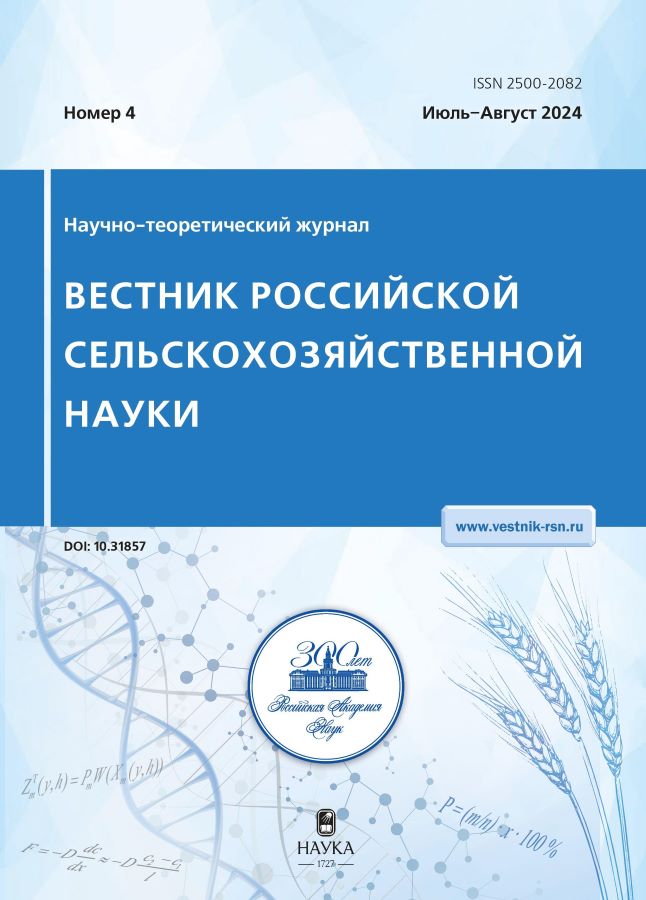Biological effect of dual-frequency laser pulse radiation during pre-sowing treatment of rice seeds at early stages of development under stressful environmental conditions
- Authors: Apasheva L.M.1, Savransky V.V.2, Budnik M.I.3, Smurova L.A.1, Ovcharenko E.N.1, Kasaikina O.T.1, Lobanov A.V.1,4, Dyachenko I.V.3, Grudzinsky A.V.3, Sergeev S.N.5, Taraskin K.A.5, Barnashova E.K.6, Vertikova E.A.6
-
Affiliations:
- N.N. Semenov Federal Research Centre for Chemical Physics of the Russian Academy of Sciences
- Prokhorov General Physics Institute of the Russian Academy of Sciences
- Russian Academy of Missile and Artillery Sciences
- Moscow Pedagogical State University
- Institute of Engineering Acoustics
- Russian State Agrarian University – Moscow Timiryazev Agricultural Academy
- Issue: No 4 (2024)
- Pages: 72-76
- Section: Crop Production and Selection
- URL: https://transsyst.ru/2500-2082/article/view/659280
- DOI: https://doi.org/10.31857/S2500208224040132
- EDN: https://elibrary.ru/xkvflx
- ID: 659280
Cite item
Abstract
The biological effect of two-frequency laser pulsed radiation produced on copper vapor during pre-sowing treatment of rice seeds of Veles and Leader varieties at early stages of development in extreme stressful environmental conditions has been studied. The copper vapor laser used in the experiment had the following output characteristics: wavelengths of 510.6 nm (green radiation line) and 578.2 nm (yellow radiation line), pulse duration of 15 ns, repetition frequency of 10 kHz, total pulse power of 10 kW, energy-power ratio between the green and yellow radiation lines 3/1 The interaction of laser radiation with wavelengths of 510.6 and 578.2 nm in the nonlinear medium of the seed caused the formation of additional wavelengths: a total wavelength of 271 nm (ultraviolet radiation) and a difference wavelength of 4.37 microns. Exposure to each of the four wavelengths in its spectral range could lead to the initiation of at least four radiation-induced biochemical reactions. It is shown that pre-sowing treatment of rice seeds with two-frequency laser pulsed radiation for 5–20 seconds had a stimulating effect on the growth and development of rice (the greatest effect was when exposed to 5–10 seconds), and also increased its stability when grown in extreme stressful environmental conditions (moisture deficiency, depleted soil) at early stages of development.
Full Text
About the authors
L. M. Apasheva
N.N. Semenov Federal Research Centre for Chemical Physics of the Russian Academy of Sciences
Author for correspondence.
Email: ziraf@mail.ru
PhD in Biological Sciences
Russian Federation, MoscowV. V. Savransky
Prokhorov General Physics Institute of the Russian Academy of Sciences
Email: ziraf@mail.ru
PhD in Physical and Mathematical Sciences
Russian Federation, MoscowM. I. Budnik
Russian Academy of Missile and Artillery Sciences
Email: ziraf@mail.ru
PhD in Biological Sciences
Russian Federation, MoscowL. A. Smurova
N.N. Semenov Federal Research Centre for Chemical Physics of the Russian Academy of Sciences
Email: ziraf@mail.ru
PhD in Chemical Sciences
Russian Federation, MoscowE. N. Ovcharenko
N.N. Semenov Federal Research Centre for Chemical Physics of the Russian Academy of Sciences
Email: ziraf@mail.ru
PhD in Chemical Sciences
Russian Federation, MoscowO. T. Kasaikina
N.N. Semenov Federal Research Centre for Chemical Physics of the Russian Academy of Sciences
Email: ziraf@mail.ru
Grand PhD in Chemical Sciences
Russian Federation, MoscowA. V. Lobanov
N.N. Semenov Federal Research Centre for Chemical Physics of the Russian Academy of Sciences; Moscow Pedagogical State University
Email: ziraf@mail.ru
Grand PhD in Chemical Sciences
Russian Federation, Moscow; MoscowI. V. Dyachenko
Russian Academy of Missile and Artillery Sciences
Email: ziraf@mail.ru
PhD in Engineering Sciences
Russian Federation, MoscowA. V. Grudzinsky
Russian Academy of Missile and Artillery Sciences
Email: ziraf@mail.ru
PhD in Engineering Sciences
Russian Federation, MoscowS. N. Sergeev
Institute of Engineering Acoustics
Email: ziraf@mail.ru
Grand PhD in Biological Sciences
Russian Federation, DubnaK. A. Taraskin
Institute of Engineering Acoustics
Email: ziraf@mail.ru
Grand PhD in Chemical Sciences
Russian Federation, DubnaE. K. Barnashova
Russian State Agrarian University – Moscow Timiryazev Agricultural Academy
Email: ziraf@mail.ru
PhD in Agricultural Sciences
Russian Federation, MoscowE. A. Vertikova
Russian State Agrarian University – Moscow Timiryazev Agricultural Academy
Email: ziraf@mail.ru
Grand PhD in Agricultural Sciences
Russian Federation, MoscowReferences
- Apasheva L.M., Smurova L.A., Kasaikina O.T. i dr. Sposob povysheniya vskhozhesti semyan i stressoustojchivosti seyancev hvojnyh porod // Patent RF № 2790449. Oficial’nyj byulleten’ «Izobreteniya. Poleznye modeli», 2023. № 6. Opublikovano: 21.02.2023.
- Grigor’yanc A.G., Kazaryan M.A., Lyabin N.A. Lazery na parah medi. M.: Fizmatlit, 2005. 312 s.
- Dolgovyh O.G., Krasil’nikov V.V., Gaztdinov R.R. Optimizaciya lazernoj predposevnoj obrabotki semyan zernovyh kul’tur. Izhevsk: RIO FGBOU VPO Izhevskaya GSKHA, 2014. 122 s.
- Domcheva E. Rosstat nazval samye populyarnye u rossiyan produkty // Rossijskaya gazeta, 01.05.2016. https://rg.ru/2016/05/01/rosstat-nazval-samye-populiarnye-u-rossiian-produkty.html
- Zhurba P. Praktika primeneniya lazernyh agrotekhnologij na Kubani // Fotonika. 2014. № 5. S. 90–103.
- Zavaleeva A., Rossinskij V. Uglerodnyj sled ot ispol’zovaniya udobrenij // HPBS. https://hpb-s.com/news/uglerodnyj-sled-ot-udobrenij.
- Zelenskij G.L. Sort risa Lider: biologicheskoe obosnovanie elementov agrotekhniki // Nauchnyj zhurnal KubGAU. 2019. № 147(03). https://doi.org/10.21515/1990-4665-147-019
- Krylov O.N., Kiselev M.M., Reshetnikov A.E. i dr. Predposevnaya opticheskaya obrabotka semyan zernovyh kul’tur na primere ozimoj rzhi «Falenskaya 4» // Hranenie i pererabotka sel’hozsyr’ya. 2023. № 2. S. 214–230. https://doi.org/10.36107/spfp.2023.439
- Petropavlovskaya Yu. Ris zemli: samaya populyarnaya eda v mire // Vokrug sveta. 2015. № 10. https://www.vokrugsveta.ru/article/235439/.
- Piskarev I.M. Obrazovanie perekisi vodoroda v vodnyh rastvorah pod dejstviem UF-S izlucheniya // Himiya vysokih energij. 2018. T. 52. № 3. S. 194–198.
- Rubcova N.A., Apasheva L.M., Lobanov A.V. i dr. Poluchenie peroksida vodoroda fizicheskimi metodami: perspektiva primeneniya v teplichnyh kompleksah // Mat. IX Mezhd. kongressa “Biotekhnologiya: sostoyanie i perspektivy razvitiya”, 20–22 fevralya 2017 g. Moskva. T. 2. S. 83–84.
- Sergeev S.N., Budnik M.I., Lebedev S.V. i dr. Sposob uvelicheniya urozhajnosti zernovoj kul’tury tritikale putem opryskivaniya vodnym rastvorom peroksida vodoroda i ciklogeksanona nadzemnoj chasti rastenij v period pozdnej vegetacii // Patent RF № 2797916. Oficial’nyj byulleten’ «Izobreteniya. Poleznye modeli», 2023. № 17. Opublikovano: 13.06.2023.
- Strebkov D.S., Budnik M.I., Dushkov V.Yu. i dr. Povyshenie urozhajnosti ozimoj pshenicy s pomoshch’yu ekologicheski chistogo vodnogo rastvora peroksida vodoroda prirodnoj koncentracii // Vestnik rossijskoj sel’skohozyajstvennoj nauki. 2022. № 4. S. 64–67. https://doi.org/10.31857/2500-2082/2022/4/64-67, EDN: BJSFK.
- Yuran S.I., Zaripov M.R., Vershinin M.N. Ustrojstvo lazernoj predposevnoj obrabotki semyan // Izvestiya Orenburgskogo gosudarstvennogo agrarnogo universiteta. 2022. T. 95. № 3. S. 131–134. https://doi.org/10.37670/2073-0853-2022-95-3-131-134
Supplementary files











